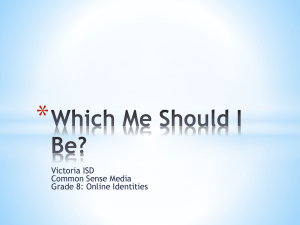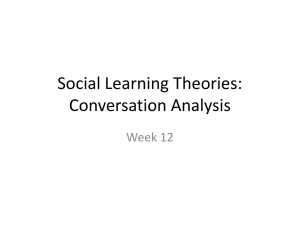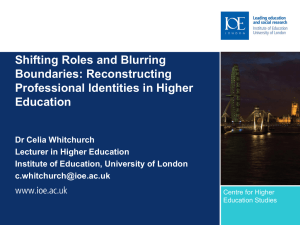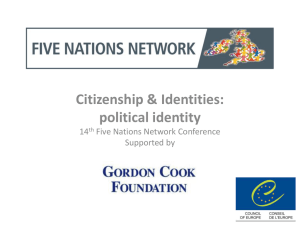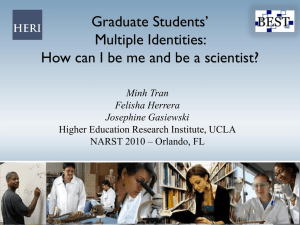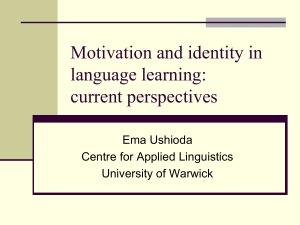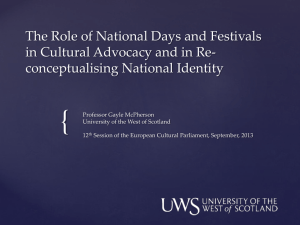Researching Identity and Identifying Researchers
advertisement
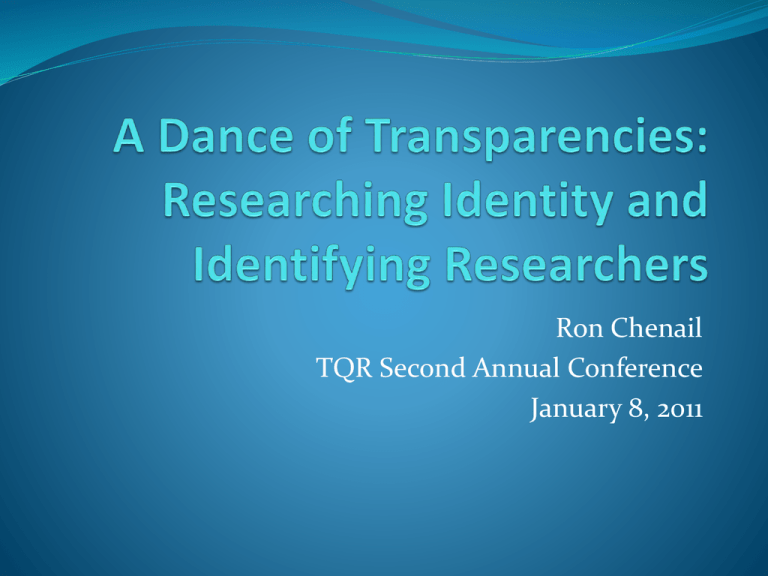
Ron Chenail TQR Second Annual Conference January 8, 2011 Plenary Overview Pre-Construction Construction De-Construction Re-Construction Post-Construction Plenary Defined Fully attended by all qualified members The American Heritage Dictionary of the English Language, Fourth Edition (2004) Role of the Plenary Address Introduction and Orientation Informative Evocative Provocative Meta-Perspective Preeminence of Identity Taking its place alongside such core metaphors as culture, phenomenon, discourse, and narrative, identity has emerged as an important trope in qualitative research. Be it people's sense of themselves as members of a family, culture, corporation, or the world society, qualitative researchers are interested in learning how people come to define themselves within their varied contexts. Conference Examples Language, Gender, & Identity in an English Language Learning CMC Environment Identity Construction through Active Listening in an Online Environment Se Echa Pa’lante Pero Se Pierde Mucho: Dominican Return Migrants’ Identities after Retirement Examining the Influence of Skin Color Values on Hispanic Women's Identity Beliefs Struggles with Identity This area of research is also fraught with controversy as researchers and their research participants struggle with gender, sexual, cultural, brand, product, customer, and corporate identities and the methodological and ethical decisions entailed in studying such phenomena. Conference Examples Perspectives on Researcher Identity: An Exploration of the Personal, Interpersonal and Transpersonal ‘Halfie’ Research Identity: On the Intricacies of Being, Becoming, and Belonging(s) Writing, Emotion, and Learning: the Influence of Researcher Identity and Experience on Analysis and Findings The Researcher, the Daughter and Me: Coping with My Three Selves Transparency of Identity An associated concern is how do we clearly and ethically identify ourselves as researchers to our research participants, clients, and colleagues and how they come to identify us? How transparent do we become as we dance with our own self-identity and the identities of others? Identity Difference As these dance steps are made, how do we as producers and consumers of these (e)merging arcs make decisions of quality and utility? As we explore these self-narratives and narratives of others, what are the differences that make a difference in our qualitative research? Identity Defined Identify suggests both a sense of the individual: Identity: The collective aspect of the set of characteristics by which a thing is definitively recognizable or known. The American Heritage Dictionary of the English Language, Fourth Edition (2004) And a sense of the relational: Identity: The set of behavioral or personal characteristics by which an individual is recognizable as a member of a group. The American Heritage Dictionary of the English Language , Fourth Edition (2004) Identity Defined Identify also suggests both a sense of uniqueness: Identity: The distinct personality of an individual regarded as a persisting entity; individuality. The American Heritage Dictionary of the English Language, Fourth Edition (2004) And a sense of sameness: Identity: The quality or condition of being the same as something else. The American Heritage Dictionary of the English Language, Fourth Edition (2004) Identity as Metaphor Three Parts to a Metaphor Two distinct but connectable parts The perspectives each brings to the other Individual and Relational / Unique and Same Someone and Someone Else Fluid and Multifaceted Epistemology of Identity Identity is discovered or recovered Identity is created or performed Identity is co-constructed and negotiated (Lavis, 2010) Identity Implies Population-Sample Relationship Nature or Logic of this Relationship Deductive Inductive Abductive Some or all of the above Identity Implies So these relational dualisms suggest we should be sensitive to both How we identify as And How we identify with Researcher Identity As researchers reflecting on our own identities Who, What, When, Where, Why and How do we identify ourselves as something? And Who, What, When, Where, Why and How do we identify ourselves with something? Researcher Identifies Others As researcher reflecting on the identities of others Who, What, When, Where, Why and How do we identify others as something? And Who, What, When, Where, Why and How do we identify others with something? Ethical Imperative of Identity You may not be able to choose how someone identifies you as something or someone else, BUT You should be aware how you identify yourself with something or someone else, AND ESPECIALLY You should be aware how you identify someone with something or someone else. Conceptualizing Yourself Personal Identities Professional Identities Disciplinary Identities Methodological Identities Relational Identities Personal Identities Gender Sexuality Age Cultural Professional Identities Principal Investigator Researcher Professor Consultant Change-Agent Disciplinary Identities Psychologist Sociologist Anthropologist Nurse Educator Market Researcher Multi-disciplinarian Methodological Identities Ethnographer Autoethnographer Phenomenologist Action Researcher Discourse Analyst Life Historian Grounded Theorist Program Evaluator Relational Identities Curiosity Confirmation Comparison Changing Collaborating Critiquing Combining (Chenail, 2000) Institutional Review Board How you identify yourself How you identify “participants” How you inform participants How you de-identify Instrumentation Data Generation Data Analysis Data Generation Empathy Switching Attending to the one and the someone else Data Generation Dual-Dependence To enable To disable Data Analysis Preserving uniqueness while considering sameness Valuing multiple identities Expressing stability while acknowledging fluidity Data Analysis What is the evidence? What is evident? Quality Control Transparency Reflection Identity Ubiquity All research involves identity Sometimes identity is more overt than others Identity ignorance or opaqueness does not lessen ethical responsibility Identity is an ongoing responsibility Questions, Comments, and Conversation References The American Heritage Dictionary of the English Language, Fourth Edition. (2004). Boston: Houghton Mifflin Company. Chenail, R. J. (2000). Navigating the "seven c's": Curiosity, confirmation, comparison, changing, collaborating, critiquing, and combinations. The Qualitative Report, 4(3/4). Retrieved from http://www.nova.edu/ssss/QR/QR4-3/sevencs.html Lavis, V. (2010). Multiple researcher identities: Highlighting tensions and implications for ethical practice in qualitative interviewing. Qualitative Research in Psychology, 7(4), 316-331. Contact Ron Chenail, Ph.D. The Qualitative Report Nova Southeastern University 3301 College Avenue Fort Lauderdale, Florida 33317 USA Email: ron@nova.edu Web: http://www.nova.edu/ssss/QR/

